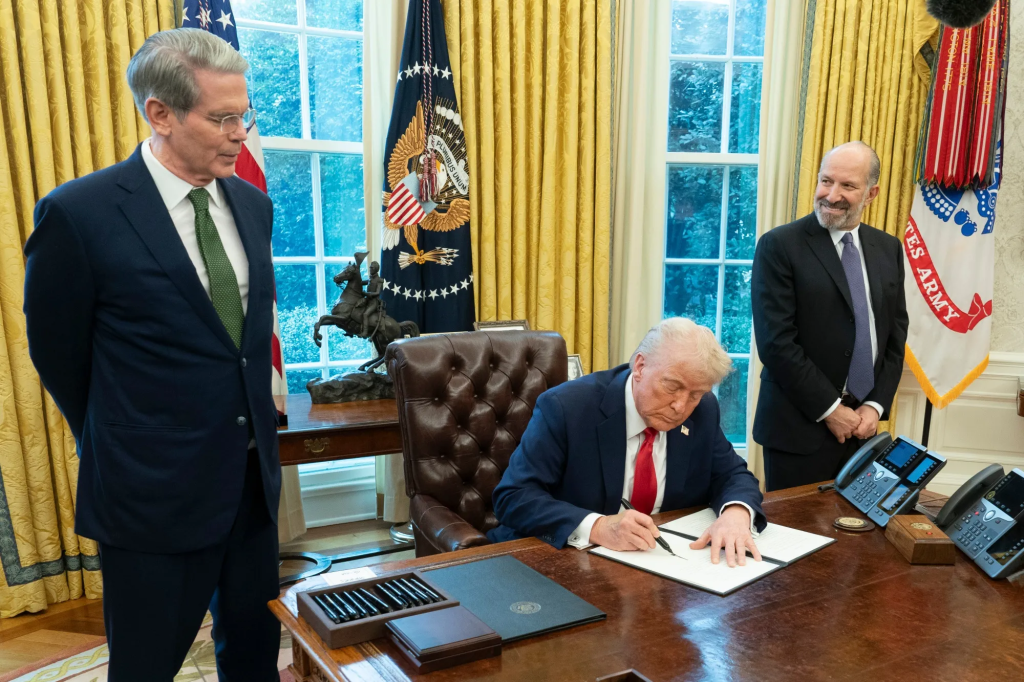President Donald Trump took a bold step by signing an executive order to establish the United States’ first-ever sovereign wealth fund. The announcement, made in the Oval Office, sets the stage for a significant shift in the federal government’s approach to economic development and investment. While sovereign wealth funds (SWFs) are a common financial tool in many countries, their implementation in the U.S. raises important questions about funding, structure, and purpose.
What Is a Sovereign Wealth Fund?
A sovereign wealth fund is a state-owned investment vehicle used to manage a nation’s surplus wealth. Unlike pension funds, which cater to individual needs, SWFs aim to generate returns that benefit the entire population. These funds often invest in diverse assets such as stocks, bonds, real estate, and infrastructure projects, ensuring long-term economic stability and growth.

Globally, there are over 90 sovereign wealth funds managing assets worth more than $8 trillion. Leading examples include Norway’s Government Pension Fund Global ($1.8 trillion), the China Investment Corporation ($1.3 trillion), and Abu Dhabi’s Investment Authority ($1.1 trillion). These funds are typically financed through budget surpluses or revenue from natural resources like oil and gas.
Why Create a U.S. Sovereign Wealth Fund?
Trump’s executive order represents a departure from traditional fiscal policy. Historically, the U.S. has run large budget deficits, limiting room for surplus-driven investments. However, Trump envisions new funding sources, including tariffs, government asset monetization, and private partnerships.

During his presidential campaign, Trump proposed using an SWF to finance infrastructure projects and boost domestic manufacturing. The goal is to reduce Treasury debt reliance while enhancing America’s economic resilience and influence.
TikTok and National Security Implications
A surprising element of Trump’s announcement involved TikTok. The administration previously pressured the China-owned social platform to divest U.S. interests over security concerns. Trump suggested the new fund could facilitate TikTok’s purchase as a strategic investment.
This underscores a broader potential for the SWF to address national security alongside economic development.
Challenges and Lingering Questions
Despite its ambitious scope, establishing a U.S. sovereign wealth fund presents several challenges:
- Funding Sources: Unlike oil-rich nations like Norway and Saudi Arabia, the U.S. lacks a natural resource-based revenue stream to fund its SWF. Treasury Secretary Scott Bessent has suggested monetizing existing government assets and leveraging tariff revenues, but specifics remain vague.
- Governance and Transparency: Sovereign wealth funds often face scrutiny over their governance structures. Ensuring transparency and accountability will be critical to avoid conflicts of interest or mismanagement.
- Legislative Hurdles: The executive order tasks the Treasury and Commerce Departments with developing a detailed plan, including legal considerations and potential legislative requirements. Gaining bipartisan support in Congress could prove challenging.
- Competition with Global Giants: Trump envisions the U.S. sovereign wealth fund becoming one of the largest globally, potentially exceeding $2 trillion. However, achieving this scale would require significant financial innovation and strategic investments.
A New Chapter for U.S. Economic Policy
If successfully implemented, the U.S. sovereign wealth fund could reshape the nation’s financial landscape. It represents a shift toward a more proactive role for the federal government in economic development, reminiscent of similar proposals studied by former President Joe Biden’s administration. By investing in infrastructure, technology, and other strategic sectors, the fund could bolster America’s competitive edge on the global stage.
The inclusion of TikTok in this discussion further illustrates the evolving nature of economic tools in addressing geopolitical concerns. As Trump stated, “We’re going to monetize the asset side of the U.S. balance sheet for the American people.” Whether this ambitious vision materializes remains to be seen, but the establishment of a sovereign wealth fund marks a pivotal moment in U.S. policy.
The creation of a U.S. sovereign wealth fund under Trump’s executive order is a bold move with far-reaching implications. It raises important questions about funding, governance, and strategic priorities, while also offering opportunities to invest in the nation’s future. As the Treasury and Commerce Departments begin crafting the details, the world will watch closely to see if America can successfully adopt this model and join the ranks of nations leveraging sovereign wealth funds for economic growth and stability.


